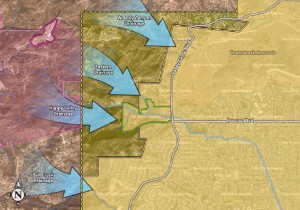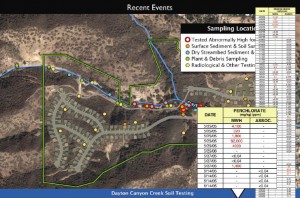One hundred and fifty single-family homes are planned on 64.2 acres out of the development’s 359.4 total acreage. Dayton Creek runs through the project and is fed by Rocketdyne’s Happy Valley drainage, which has undergone massive excavation due to perchlorate contamination.
The project’s 1999 Final Environmental Impact Report (FEIR), fully aware of the lab’s proximity, didn’t note impacts on the development from SSFL in its “areas of controversy†section. The Los Angeles Regional Water Quality Control Board estimates that 69 million gallons of discharges, from SSFL rocket engine tests alone, go down Dayton and an adjacent creek every year. The developers did note, however, that the FEIR is not a “definitive investigation of contamination.â€
On May 28, 2004, the Centex-Sterling Homes Company bought over 355 acres west of Valley Circle Boulevard at Roscoe Boulevard. The 151 new homes will be approximately 3,500 square foot, two-story residences on 10,000 square foot lots, some within ten feet of Dayton Canyon Creek.
The amount of contamination found has been astronomical. After a May 2005 article in the Los Angeles Daily News appeared questioning why the developers had never tested for toxins despite being just 1.3 miles downhill from the lab, Centex Homes finally did test and found up to 62,000 parts per million of the rocket fuel oxidizer perchlorate in the sediment along Dayton Canyon Creek. These are absolutely immense concentrations.
When these amazing results came out, the paper followed up two months later with an article where Centex developer John Fitzpatrick was quoted with coming up with the most unlikely determination after the high perchlorate readings: “The only conclusion [the testing contractor has] been able to draw is where it’s not coming from. It’s not coming from Rocketdyne.â€
We could not have disagreed more. Common sense dictates that perchlorate, a solid rocket fuel used in huge amounts at SSFL just up Dayton Creek from the proposed housing development, would be logically the source of the Centex development’s contamination. Perchlorate was used at SSFL, there was extensive contamination with perchlorate at SSFL, and much of that contamination at SSFL was in “Happy Valley” at the headwaters of Dayton Creek, which flows through the proposed development and in which the perchlorate was found.
“Cesium-137 was found in the Dayton Canyon West area at levels on average twice that of local background,†according to Dan Hirsch of the Committee to Bridge the Gap in a November 13, 2006 report called Radioactive Contamination at Dayton Canyon from the Santa Susana Field Laboratory — Comments on Radiological Monitoring.
“Five of the fourteen samples taken in that area were “hotter†than the hottest of any measured value for local background,†states the report. “The developer used a detection limit for strontium-90 so high that levels way over background would come back “non-detectâ€; even so, three of the strontium measurements were higher than anything seen in local background. Geiger counter measurements were on average several times background. The pattern of contamination was consistent with SSFL as the source, with higher readings in the part of the Dayton property closest to SSFL. Even so, when averaged over the entire Dayton Canyon area, cesium-137 measured on average 1.6 times average background. The hottest cesium measurements found in Dayton were 1.77 times as radioactive as the hottest measurements made of local background.â€
CBG’s report is must reading for folks concerned about this proposed development west San Fernando Valley development just below Rocketyne. Even though the current recession seems to have made the viability of any kind of upscale housing development tenuous at best, let alone one beset by the problems this one has faced, the issue remains alive.
RCC will continue to vigilantly monitor Dayton Canyon to keep you informed of this issue.

